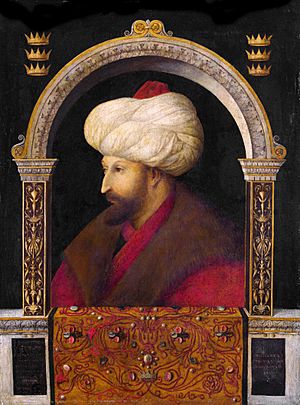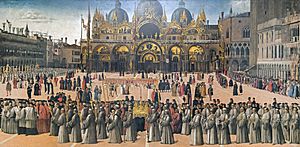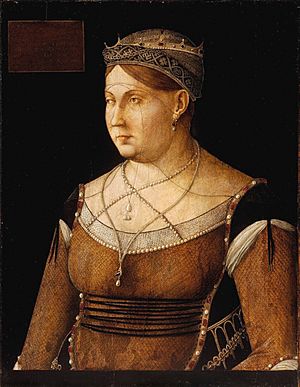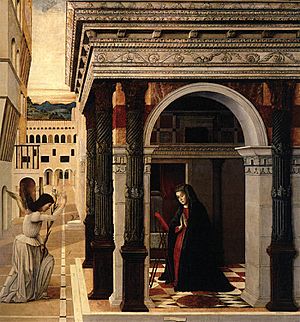Gentile Bellini facts for kids
Quick facts for kids
Gentile Bellini
|
|
|---|---|

Gentile Bellini, Self-portrait, 1496. Kupferstichkabinett, Berlin (KdZ 5170)
|
|
| Born | c. 1429 |
| Died | 23 February 1507 |
| Resting place | Basilica di San Giovanni e Paolo |
| Known for | Painter, noted for portraits and paintings of Middle Eastern scenes |
|
Notable work
|
Sultan Mehmed II and others |
Gentile Bellini (born around 1429 – died 1507) was a famous Italian painter. He belonged to the Venetian school of painting. This means he was part of a special group of artists from Venice, Italy.
Gentile came from a very important family of painters in Venice. For a long time, people thought he was even better than his younger brother, Giovanni Bellini. Today, Giovanni is more famous.
From 1474, Gentile was the official artist for the Doges of Venice. A Doge was like the leader or ruler of Venice. Gentile painted many portraits of these important people. He also created very large paintings with many figures. These were often for the Scuole Grandi of Venice. These were rich groups of people who played a big role in Venetian social life.
In 1479, the Venetian government sent him to Constantinople. This was because the Ottoman Sultan Mehmed II wanted an artist. Gentile returned home the next year. After this trip, many of his paintings showed scenes from the East. He helped start the Orientalist art style in Western painting. His famous portrait of the Sultan was copied and became known across Europe.
Contents
Biography
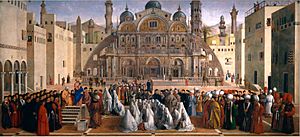
Gentile was born into Venice's leading family of artists. His father, Jacopo Bellini, was a pioneer in using oil paint. His brother was Giovanni Bellini, and his brother-in-law was Andrea Mantegna. Gentile was named after his father's teacher, Gentile da Fabriano.
Gentile learned to paint in his father's workshop. Even though his family members are more famous today, Gentile was considered one of the greatest painters in Venice during his time. He always had many jobs. His skill at painting portraits showed up when he was still young.
Paintings and Major Works
Gentile's earliest known painting is The Blessed Lorenzo Giustinian (1445). It is one of the oldest oil paintings still existing in Venice. You can see it at the Accademia Museum. In the 1450s, Bellini worked with his brother, Giovanni Bellini. They painted for the Scuola Grande di San Marco. From 1454, Gentile also became the official portrait painter for the Doges of Venice. An example is his painting of Doge Giovanni Mocenigo.
Many of Gentile Bellini's remaining works are very large paintings. He made them for public buildings, like the Scuola Grande di San Giovanni Evangelista. Bellini was one of the artists hired to paint a series of 10 large pictures. This series is called The Miracles of the Relic of the Cross. These paintings celebrated a special relic (a holy object) of the Holy Cross. Gentile's paintings in this series include the Procession of the True Cross in Piazza San Marco (1496). Another is the Miracle of the True Cross at the S. Lorenzo Bridge (1500). This painting even includes a self-portrait of Gentile and his brother Giovanni.
Bellini and the East
Venice was a very important city for trade and culture. It connected Europe with the eastern Mediterranean Sea and places in Asia and Africa. Gentile was the most respected painter in Venice during his life. So, in 1479, the Venetian government chose him for a special job. He was sent to work for Sultan Mehmed II in Constantinople.
Besides painting, Gentile also acted as a cultural ambassador for Venice. Sultan Mehmed II was very interested in Italian art and culture. He had tried many times to have Italian artists paint him. He finally got his wish with Gentile. It is believed that Gentile painted the famous portrait of Mehmed II. This painting is now in the National Gallery, London.
Istanbul and the Ottoman Empire
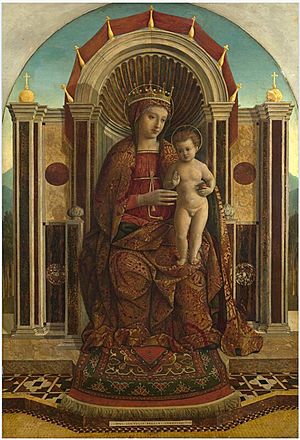
In September 1479, Gentile went to Istanbul. This city was the new capital of the Ottoman Empire. His visit was part of a peace agreement between Venice and the Turks. After this trip, an "Oriental" style appeared in some of his paintings. Examples include a portrait of a Turkish artist and St. Mark Preaching at Alexandria. His brother, Giovanni Bellini, finished the last painting.
Greece and Other Eastern Influences
Gentile's art was also influenced by other parts of the East. This included the Byzantine Greek Empire and Venice's trading partners in North Africa and Levant. Venice had a long history with the Eastern Mediterranean. Saint Mark, Venice's patron saint, was from Alexandria, Egypt. Venice's main church, the Basilica of San Marco, was built in his honor. It was designed in the Greek Byzantine style.
Even though Constantinople fell to the Ottoman Turks in 1453, Greek Byzantine culture still influenced Venetian art. Many Greek Christians moved away from Muslim rule and came to Venice. It was during this time that Gentile painted the portrait of Queen Caterina Cornaro of Cyprus. This is the second known portrait of the queen. It is now in the Szepmuveszeti Museum in Budapest.
Later Years and Legacy
Many of Bellini's most important paintings were in the Doge's Palace in Venice. Sadly, a fire destroyed them in 1577. Only a few of his other works remain today. These include the large narrative paintings The Procession in Piazza San Marco and The Preaching of Saint Mark in Alexandria. He made these in his final years.
Not many of Gentile's artworks from the 1470s and 1480s still exist. Most of what remains are the pieces he made in Constantinople. Also, many paintings and drawings made by his workshop have been mistakenly thought to be by Gentile himself. This has sometimes made people think he was not as skilled as his famous brother Giovanni.
Gentile Bellini was buried in the Basilica di San Giovanni e Paolo. This church was a traditional burial place for the Doges. In recent years, people have become more interested in Gentile's work again. Especially in how his art shows the cultural exchange between Europe and the Levant.
Selected Works
- Madonna Enthroned with Child (1475–1485) - National Gallery, London
- Portrait of Doge Giovanni Mocenigo (1478–1485) - Museo Correr, Venice
- Procession in St. Mark's Square (1496) - Gallerie dell'Accademia, Venice
- Miracle of the True Cross at the Bridge of S. Lorenzo (1500) - Gallerie dell'Accademia, Venice
- Miracle of the Reliquary of the Cross (1500)
- St. Mark Preaching in Alexandria (1504–1507) - Pinacoteca di Brera, Milan
- Man with a Pair of Dividers
- St. Dominic
- Mehmet the Conqueror
- Portrait of Caterina Cornaro, Queen of Cyprus - Szépmüvészeti Múzeum, Budapest
- The Annunciation - Thyssen-Bornemisza Museum, Madrid, Spain.
See also
 In Spanish: Gentile Bellini para niños
In Spanish: Gentile Bellini para niños
- List of Orientalist artists
- Orientalism


